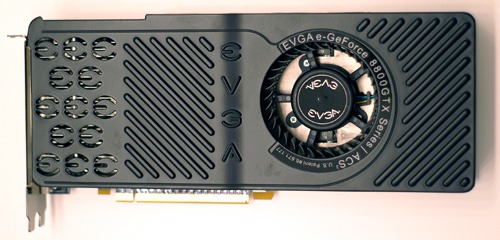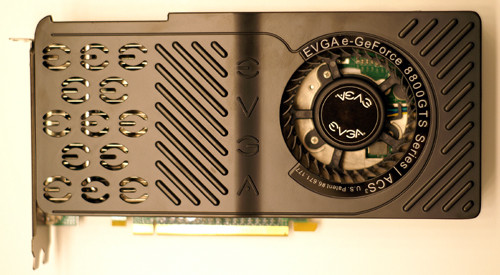EVGA e-GeForce 8800 GTX and GTS ACS3
EVGA's offerings are the most aggressively clocked cards we have with high core, shader and memory speeds. Increasing each of these clocks help universally boost performance and the end results is that EVGA offers the fastest factory clocked 8 Series graphics cards currently available.
While the fan is the same as stock, the heatsink is EVGA's ACS3 design. Potential cooling performance is nowhere near what Sparkle has to offer through its Calibre P880+ OC Edition, but at least it does perform better than the stock 8 Series HSF.


The HSF, aside from some cooling benefit, adds a nice hefty feel to the card. The solid feeling really adds to the impression of physical value, which is a nice comfort when spending so much on a single component. At the same time it is worth mentioning this isn't a card you want to forget to screw down tightly when installing.
The GTX version of the ACS3 is about $650, whereas the GTS comes in at $450. The price premium on the GTX version is very large, while the additional cost for the GTS is more manageable.
EVGA's offerings are the most aggressively clocked cards we have with high core, shader and memory speeds. Increasing each of these clocks help universally boost performance and the end results is that EVGA offers the fastest factory clocked 8 Series graphics cards currently available.
While the fan is the same as stock, the heatsink is EVGA's ACS3 design. Potential cooling performance is nowhere near what Sparkle has to offer through its Calibre P880+ OC Edition, but at least it does perform better than the stock 8 Series HSF.


The HSF, aside from some cooling benefit, adds a nice hefty feel to the card. The solid feeling really adds to the impression of physical value, which is a nice comfort when spending so much on a single component. At the same time it is worth mentioning this isn't a card you want to forget to screw down tightly when installing.
The GTX version of the ACS3 is about $650, whereas the GTS comes in at $450. The price premium on the GTX version is very large, while the additional cost for the GTS is more manageable.










20 Comments
View All Comments
chizow - Tuesday, March 13, 2007 - link
Curious why you guys didn't do physical card/chip/memory kit inspections to see if there was any *real* difference between OC and non-OC'd cards besides stock BIOS settings and some new cooler stickers. Would've been nice to see some core revision #s, mfg. dates and memory IC pics.The real test is whether the OC'd version parts have significantly more headroom than the vanilla versions that for the most part, can OC as high as these OC versions with ease.
The only factor left which you touched on but didn't see you follow up on was the clock speed of the shader core. Initially I was under the impression the shader core could only be adjusted by altering the BIOS but a few others have mentioned the shader core scales proportionately with core OCs.
DerekWilson - Tuesday, March 13, 2007 - link
both your assertions on shader core are true to a degree. the shader core can only be adjusted on its own through the bios. but increasing core clock through the driver will increase the shader clock speed as well.Palamedes - Tuesday, March 13, 2007 - link
I'm missing the Gainward card (Bliss 8800GTS Golden Sample). I bought it four weeks ago, so it definetely IS available. It is running at 550/880/1350, so it theoretically fits the gap between the BFG and the EVGA...Some1ne - Monday, March 12, 2007 - link
Seems to me like the article should have also investigated the potential of the cards to overclock beyond their factory overclocked settings. Then maybe it would have had to say "in spite of the fact that this card offers the best cooling it doesn't come with the highest clock speeds, which is a bit of a disappointment especially for the most expensive card of this roundup" about the Sparkle card, because maybe it would have turned out to have the most headroom out of all of the cards.Given that nearly every CPU and video card review published on this site includes an overclocking section, it seems odd that this article did not.
DerekWilson - Monday, March 12, 2007 - link
You do have a point about the Sparkle card -- but we already tested a card with this cooler back when the 8800 GTX launched. Overclocking wasn't significantly better than stock cooled cards.Generally, we would not recommend buying factory overclocked cards with the intention of manually overclocking them. You'll save a lot of money and get good results by going with stock cards and manually setting fan speed to 100%. Alternately, the savings can be used to invest in exotic cooling.
The value in these cards is in their factory settings and users not interested in this should avoid them in my opinion.
ViRGE - Monday, March 12, 2007 - link
There's not much worth testing on overclocking high-end cards, IMHO. They're all built using the reference design, they're not going to overclock significantly differently with just different cooling.mostlyprudent - Monday, March 12, 2007 - link
I was somewhat surprised to notice that in many of the benchmarks, the performance advantage of the GTX cards over the GTS cards scaled pretty consistantly with their price premium. For example the EVGA GTX often performed about 25% better than the EVGA GTS card with costs about 25% less.It seems that in the past, the performance difference was much smaller than the price diference between the top two ultra high end models.
DigitalFreak - Monday, March 12, 2007 - link
SUCKER!DerekWilson - Monday, March 12, 2007 - link
There is one angle we weren't able to cover -- the difference between oc'd and stock GTX cards might have a higher impact in future games ... Certainly we can only recommend cards based on the tests we have available. And while you put it a little more bluntly, our recommendation reflects the fact that spending more money on highly overclocked GTX parts does not net a proportionate return.guptasa1 - Monday, March 12, 2007 - link
I noticed there's an OC2 of the BFG offering that's overclocked further than the OC. It'd be interesting to see how it compares to these cards as I'm leaning towards this one for my new system.